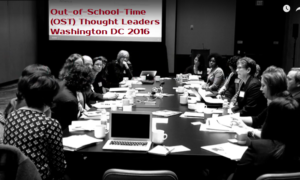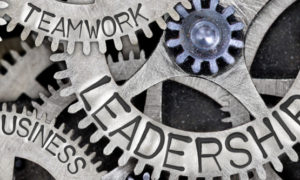 Professional development in the out-of-school-time (OST) field has been on an evolutionary curve in recent times. There has been an emphasis on building a solid professional development system for OST that has all the components needed for high-quality professional development supports for practitioners.
Professional development in the out-of-school-time (OST) field has been on an evolutionary curve in recent times. There has been an emphasis on building a solid professional development system for OST that has all the components needed for high-quality professional development supports for practitioners.
A professional development system includes established core competencies, training opportunities, training and trainer approval processes, a professional registry, a career framework with articulated certificate and degree pathways and an intentional retention strategy that includes practitioner supports and incentives.
Understanding the OST workforce has been an integral piece of building a successful professional development system, but within our DNA are inherent difficulties. OST practitioners are as multifaceted as geodes: It is only after cracking the surface of varying educational backgrounds, personal and professional experiences, and differing worldviews that the complexity and beauty of our practitioners are revealed.
But what kind of workforce are we trying to build? Staff who have a solid foundation of youth development theory and practice are central to the archetype of the OST practitioner. But how do we bring together the different aspects of each practitioner’s personality, education, experiences and interests in a manner that truly celebrates them and integrate these aspects into their professional/personal development?
Because our human capital is our most valuable asset in this field, we also need to commit ourselves to never lose sight of empowering the people who empower the (young) people. Also, we continue to find viable ways to retain well-qualified staff.
It is undeniable that the necessary knowledge and skills must be a part of the equation — but what if a shift in focus is in order? What if we intensified our efforts on personal development?
Making the shift to increase personal development opportunities would mean more chances for practitioners to improve self-awareness, develop individual talents and potential, and contribute to the realization of their dreams and aspirations. It is then that practitioners can assess their unique combination of education, experiences and interests and utilize that knowledge to construct an individually tailored blueprint of professional development goals.
The implementation of personal development opportunities are not solely for training. Various methods such as coaching, social learning, informal learning and everyday practices are inherently beneficial, and can also be customized to meet the intricate needs of an emerging workforce, bringing about a meaningful shift in focus.
What can we do as OST leaders to ensure that we are offering personal development opportunities? What fundamentals can we infuse no matter who, no matter what, no matter when? Here are a few possibilities:
- Embracing different work styles
Work styles are the basis of how we organize our work, manage our time, teach and learn, interact with others and communicate. Increasing awareness of our work style not only gives us insight into ourselves, but also has the capability to build stronger teams, minimize conflict and promote a richer sense of self.
There are several different theories that provide a framework to understanding the way we work such as the Myers Briggs Type Instrument (MBTI), but there are also simple, easy to use and understand tools such as Compass Points that could be helpful in identifying, developing and optimizing individual preferences.
[Related: How Can We Protect Teen Workers from Occupational Dangers?]
It is essential to ensure that we are allowing different ways of working to be honored. By being proactive in implementing practices that allow different work styles to shine, we cultivate an inclusive environment focused on strengths. Some ideas to get started include posting fun or interesting things about each style in the program space, highlighting a different style in an ongoing newsletter, integrating activities that underscore that all work styles are valued or sharing anecdotes at meetings.
- Collaboration for the soul
Building a strong sense of community and fostering meaningful relationships can assist in personal development by providing a sense of camaraderie that is necessary to face the everyday challenges of OST programming. In addition, a spirit of humor and levity at appropriate times can reinforce those relationships, fostering a truly collaborative environment. A community of people who are connected, excited about their work, celebrate each other’s accomplishments and challenge each other have the advantage of doing something truly remarkable. Some ideas to build community include providing opportunities for sharing stories, attending a training together, incorporating aspects of popular culture that could support the group’s mission and providing an avenue for staff to acknowledge each other for a job well done.
- Zoom in, zoom out
To gain perspective, sometimes it’s essential to zoom out and look at the bigger picture. Other times, a closer look may help to see things clearly. When we lose sight of the “why” in our work, it is easy to become distracted by the everyday challenges we encounter. The idea that we are a part of something greater is an important motivator for practitioners in the OST field. When we can see how our contributions make a difference, a powerful force is awakened. This usually is most felt, not by data, but by real stories told by the beneficiaries of our work — the youth. The heart of the matter does indeed matter.
How can we assist in refocusing? By capturing stories and anecdotes from youth and parents, highlighting those stories on a visual board or newsletter, presenting stories from around the country that highlight others doing great things in OST and, most importantly, celebrating practitioners’ impact and accomplishments.
- Bring in their passions, follow their strengths
When you follow passion, you follow interests. When you follow strengths, you follow motivation. Developing talents and potential based on interests and strengths is a combination that allows practitioners to do what makes them come alive, while providing enriching activities for youth. Encouraging staff to infuse their interests in programming empowers them to illustrate a fundamental principal in positive youth development — cultivating innate strengths that can be used to give back, promoting a sense of accomplishment and meaning.
Do you have a practitioner interested in drawing manga? Infuse it! Use it. It could be used as powerful way to open up avenues for personal development for a growing field.
Nicole Edwards is the professional development manager at Prime Time Palm Beach County, an intermediary nonprofit organization dedicated to fostering high quality in out-of-school-time programs.
More related articles:
School-age Care and OST: a Conversation About the OST Workforce
In the Wake of Racial Injustice … What Should Youth Workers Do?
Are You Culturally Competent? Responding to Kids’ Diverse Backgrounds and Experiences































